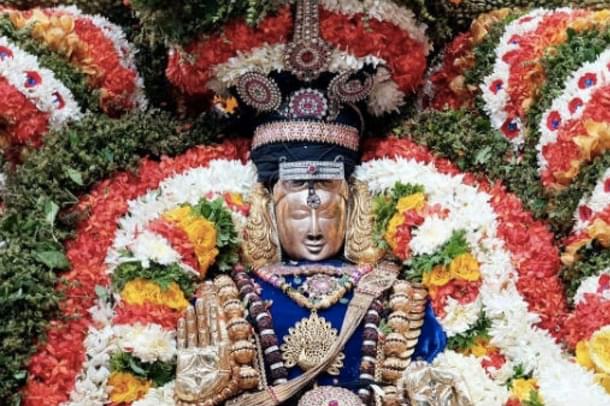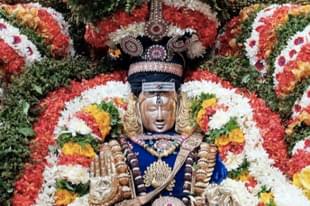Culture
The ‘Arubathi Moovar Utsavam’ Of Chennai - Ten Days Of Festivities That You Should Not Miss
K Balakumar
Apr 04, 2023, 12:36 AM | Updated Apr 04, 2023, 10:16 AM IST
Save & read from anywhere!
Bookmark stories for easy access on any device or the Swarajya app.


"It is all kaleidoscope of colour, content and culture," said the young journalist from the US looking at the concatenation of events that were unfolding on the streets of Mylapore as part of the famed 'Arubathi Moovar Utsavam'. It was the year 1995, and the journo was here in Chennai as part of some exchange program with a city-based evening newspaper (now defunct).
As a cub reporter of that daily I had taken that journalist from a daily in the US to the Moovar Utsavam, which falls on the 8th day of the annual 10-day Panguni festival of the Mylapore Karpagambal-Kapaleeswarar temple, which in a manner of speaking can be called as the presiding deities of Chennai.
As I too was a newbie to the city then, both of us roamed around the streets of Mylapore that morning and afternoon in that sticky early summer heat with wide-eyed enthusiasm.
The sing-song insistence of itinerant hawkers, the colourful plastic knick-knacks mounded on platforms, the swarm of devotees silently chanting some mantras and raising their palms together in obeisance to a passing deity in a palanquin, the noisy scrum of young boys out on the streets just for fun, the streak of devotional songs from the loud music set playing inside a shop, the regal strain of nagaswaram, the heavy blowing of conch, the fervid chants of 'Kapali, Kapali', the sweaty impatience of the police personnel standing in sentinel at pivotal points, the conflated fragrance of flowers, fruits and burning incense sticks, the blazing brightness of the summer sun reflected on glass-paneled buildings...it was a delightful cornucopia of sight, sound and smell.
We both felt time-transported from the 90s Chennai to a distant rural past.
Looking at what were exotic sights and sounds to him, the US journo was totally besotted. "I had not even heard of such an event till yesterday. Very happy that I could come and see this," he said effusively. And after a pause, added: "but had it not been mentioned to me by chance, I would have missed this beautiful event. You guys need to showcase your cultural things even more. They deserve to be."
A festivity, not a bureaucratic occasion
At that time I didn't think much of his words to be any more than the fevered praise of a goggle-eyed outsider bewitched by colourful curiosities around him.
But those lines from 28 years back came back to me a couple of weeks ago in my neighbourhood.
There was a film shooting happening on a road adjacent to my place and there was a good crowd to catch a glimpse of the events. But the nearby residents were hassled by the knot of people, mostly youngsters, gathered near the place.
One irritated resident tried to shoo away the gathering by saying 'ellam poanga poanga, inga enna arubathi moovar utsavam-a nadakuduthu?' (Everyone move away. Don't crowd as if Arubathi Moovar Utsavam is happening here.) And in the crowd, from the bunch of youngsters, one could hear 'Arubathi Moovar Utsavam na enna?' (What is this Arubathi Moovar Utsavam), and it elicited a quick reply from the crowd itself 'yarukku theriyum!' (who knows!) as they dispersed in suppressed, sardonic laughter.
The event is just anecdotal, and may or may not be representative of the larger reality among the people. Still, I couldn't help feel that we as a society have not showcased the quaint beauty of our culture and traditions adequately to our own people.
The 63-var utsavam is essentially a grand procession of the 63 Saivite saints (they are called Nayanars or Nayanmars) who sang hymns and served not only Lord Shiva but also those who worshiped Him.
This event, along with the entire 10-day festivities, date back to the time when Mylapore was a mere village and Chennai (Madras) as we know it was hardly a putative presence.
The events and the festivities are sustained in its fervour mostly by involved individuals and institutions who understand the value of history.
The HR&CE (Hindu Religious & Charitable Endowment) department, which is in charge of the temple, over the years has merely a bureaucratic grasp of things.
Its eye can't see the difference between an officious ministerial procession and a ceremonial cavalcade of Gods. Government departments are inherently built that way. More so in Tamil Nadu where the Dravidianist blinkers come in the way of celebrations that centripetal around Hindu temples and traditions.
Thiruvalluvar as a Nayanmar
The thing is, events like '63var utsavam' are not mere religious functions. Its sweep and heft cover literature and philosophy too.
For instance, the utsavam is not just about the Chennai Kapaleeswarar temple alone. It also includes the nearby Thiruvalluvar temple.
On the 63-var utsavam day, the saint poet Thiruvalluvar is taken in a palanquin to the Kapaleeswarar temple and joins the parade as the 64th saint. Though Thiruvalluvar is not one of the Nayanmars, he gets a pride of place among them. And this is the beauty and brilliance of it.
This tradition is said to be very old. Also, this festival is not about one community as is widely misinformed in Tamil Nadu.
For instance, along the procession of Thirugnanasambandar (one of the celebrated Nayanmars) is that of Sivanesan Chettiar and his daughter Poompavai (The legend of Poompavai is inextricably linked with the Kapaleeswarar temple).
In any case, most of the Nayanmars are not Brahmins. So a festival like this, though rooted in Hindu traditions, has attractions for the curious and interested.
Last year, I was in a European country for two months, and during my stay I was intrigued by a 'church tax' that was levied by the government on the salary that individuals earned.
Those who didn't want to pay this can opt out. But many people I spoke to did not. Many of them were in fact atheists.
One professor at the local university told me that he did not believe in the idea of God, but still was happy to pay the church tax. "To think a church is about religion is parochial. It helps people to feel part of a community and also keeps intact the local traditions and ethos. For a good society, sustaining its ethos is important," he said.
Pointing to a nearby 120-year-old church, he said, to see this as a mere symbol of organised religion is to commit the folly of philistines. Wise words.
I think I will venture to the Arupathi Moovar Utsavam later today and not commit the folly of philistines.




